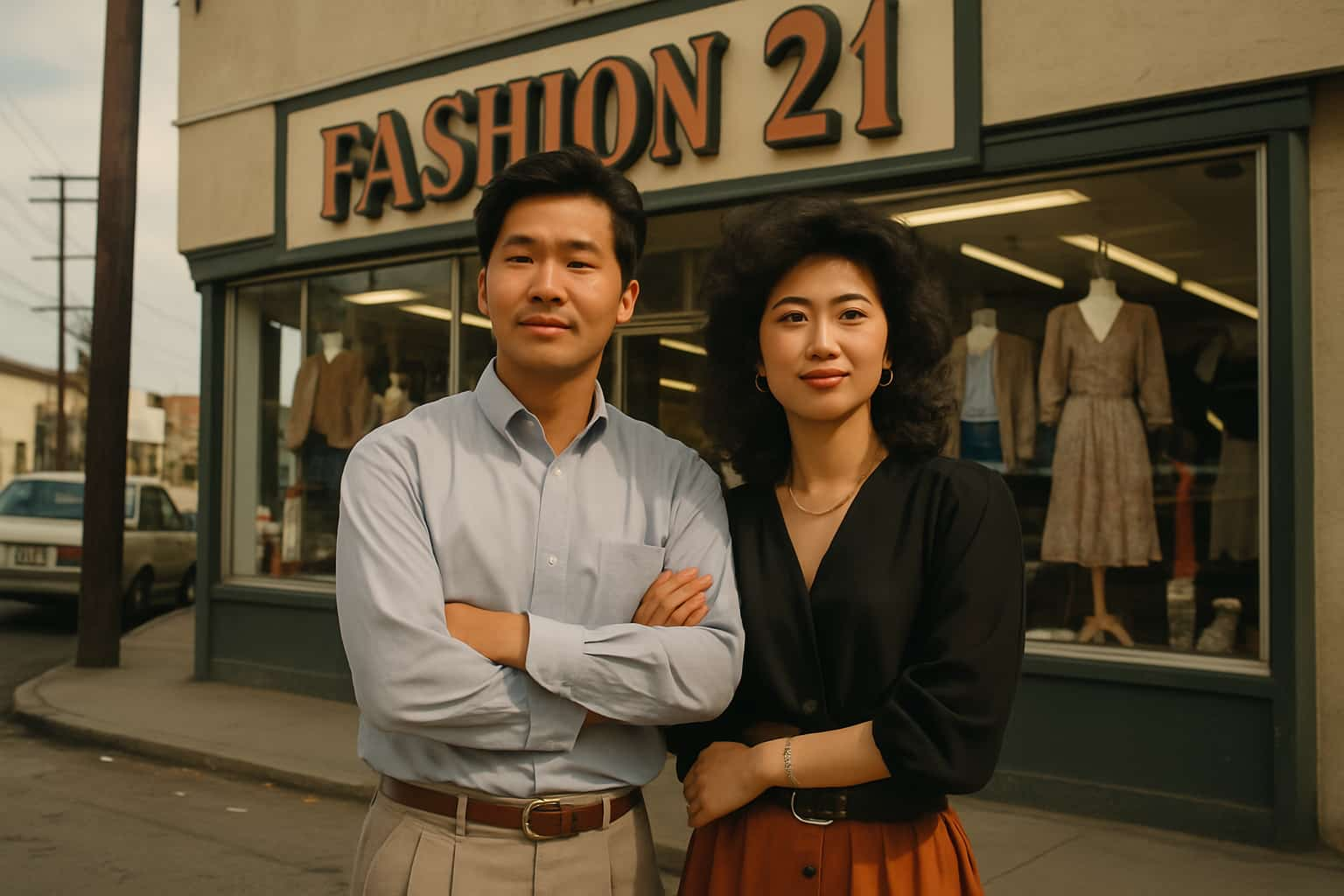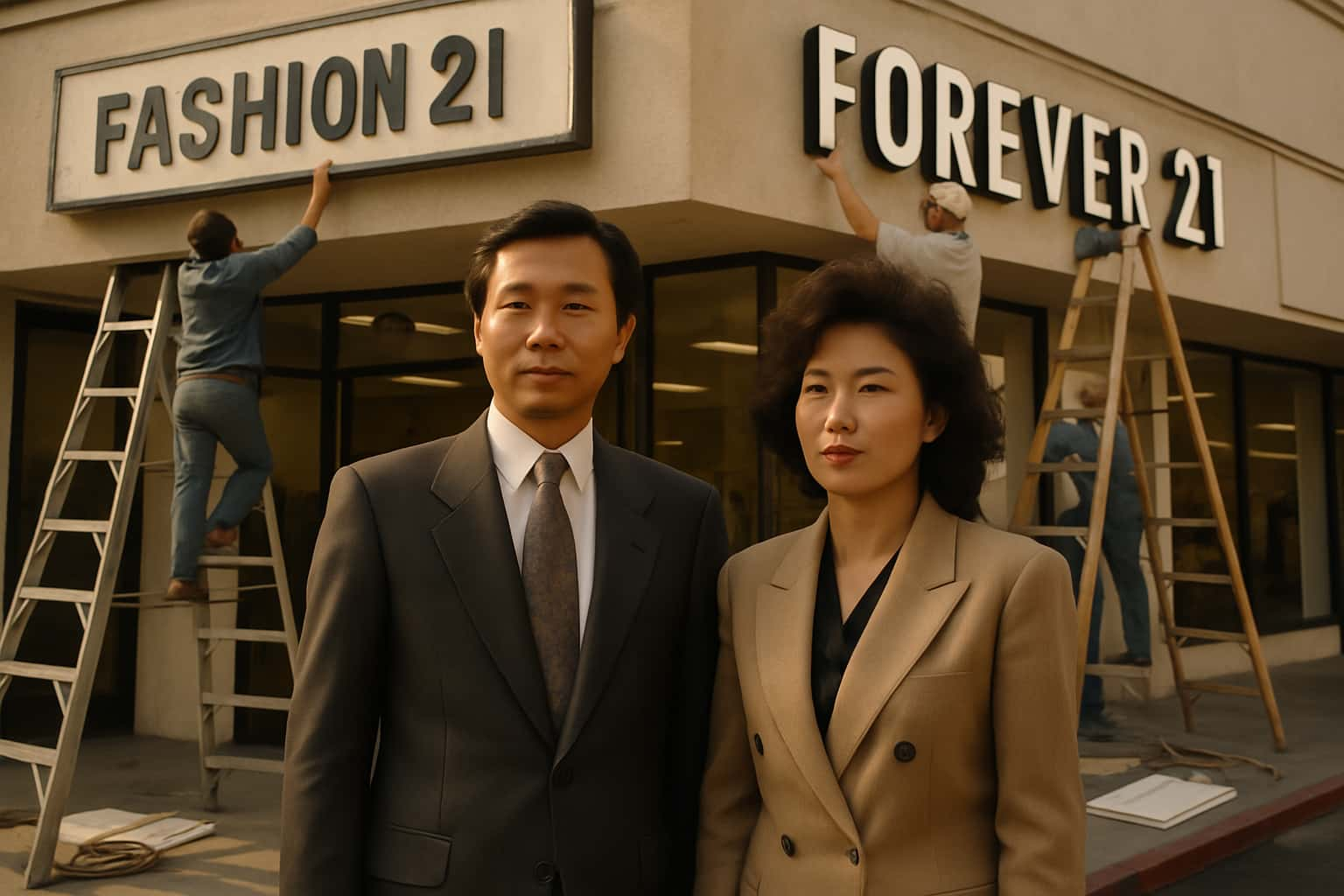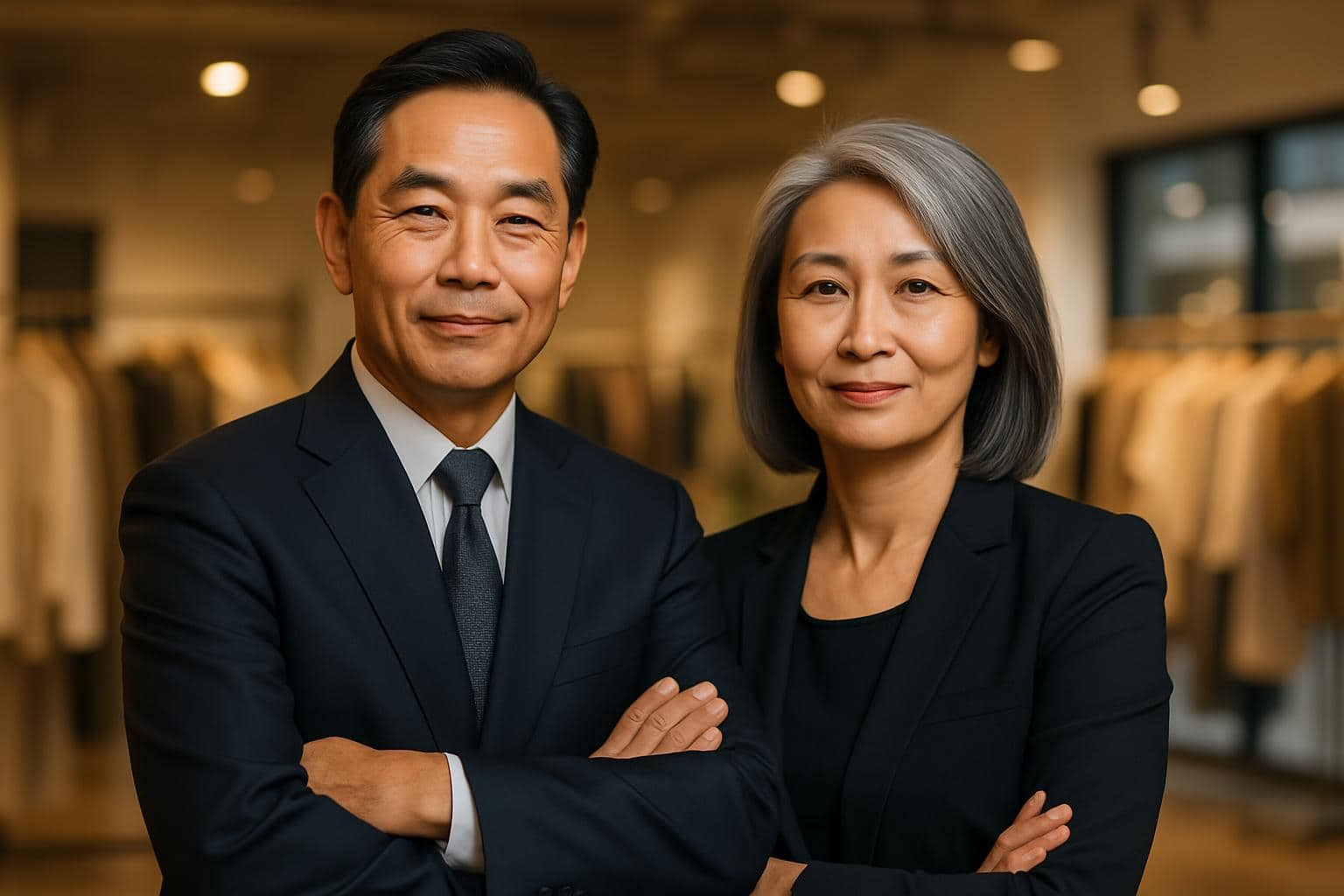Table of contents
Do Won Chang & Jin Sook Chang transformed from struggling immigrants working 19-hour days to billionaire fashion moguls who built Forever 21 into a global empire. Their story represents the ultimate American Dream realized through relentless determination, strategic vision, and unwavering faith.
Born in 1954 in Myoungdong, Seoul, Do Won Chang grew up in a modest household where poverty was a constant companion. His early years were marked by economic hardship and the daily struggle for survival. The family worked tirelessly just to make ends meet, instilling in young Do Won a work ethic that would later prove invaluable.
Early Life and Struggles

Growing up in South Korea during the 1960s and 1970s presented numerous challenges for the Chang family. Do Won’s childhood was shaped by financial constraints that limited opportunities and forced difficult choices. His parents labored in low-paying jobs, demonstrating the value of hard work through their daily sacrifices.
Education beyond high school remained out of reach for Do Won. Instead of pursuing university studies, he entered the workforce early to help support his family. The jobs available were typically labor-intensive and offered minimal compensation, reflecting the economic realities of the time.
Meanwhile, Jin Sook Chang was developing her own skills and work ethic. She learned hairdressing, a trade that would later prove crucial during their early years in America. Her practical skills and determination complemented Do Won’s ambitious spirit perfectly.
The political climate in South Korea during the late 1970s and early 1980s was tumultuous. Martial law had been imposed following the assassination of military dictator Park Chung-hee. Economic opportunities remained severely limited, and the future looked uncertain for young couples like the Changs.
Do Won had dreamed of coming to America since sixth grade. He watched as his parents visited the United States and returned with stories of opportunity and prosperity. Each month, he would tell himself “next month” he would make the journey, but years passed before the dream became reality.
Marriage became part of their strategic plan for immigration. Do Won and Jin Sook were introduced through mutual friends, following Korean tradition. Their courtship was purposeful rather than purely romantic – they agreed to meet with the specific intention of marriage and eventual immigration to America.
The year 1981 marked the pivotal moment when everything changed for the young couple. Do Won, just 22 years old, and Jin Sook, 25, made the life-altering decision to leave everything behind and pursue their American Dream. Their journey began with a flight to Hawaii, where they spent less than a day securing green cards for themselves and Do Won’s parents.
Turning Points
Arriving at Los Angeles International Airport on a Saturday, the couple faced immediate reality. They had minimal savings, limited English proficiency, and no established network beyond Do Won’s sister who lived in Los Angeles. The city sprawled before them, vast and intimidating, yet filled with possibility.
Do Won wasted no time in seeking employment. By Monday morning, just two days after arrival, he was washing dishes and preparing meals in a local coffee shop kitchen. The minimum wage of approximately three dollars per hour barely covered basic expenses, forcing him to seek additional income sources immediately.
The grueling schedule that followed would test their resolve daily. Do Won worked at the coffee shop during regular hours, then spent eight additional hours at a gas station. To supplement their income further, he started a small office cleaning business that kept him busy until midnight. This meant working 19 hours per day, seven days a week.
Jin Sook contributed by working as a hairdresser, utilizing the skills she had learned in Korea. Her steady income provided crucial stability during those early months when every dollar counted. Together, they lived frugally, saving every possible penny for their future business venture.
While pumping gas, Do Won made a crucial observation that would change their trajectory. He noticed that customers involved in the garment industry drove the nicest cars and seemed to enjoy the greatest prosperity. This sparked his curiosity about the fashion business and planted the seed for their future empire.
Breakthrough Success

After three years of relentless work and careful saving, the Changs had accumulated $11,000 in capital. This modest sum represented countless hours of labor, sacrifice, and unwavering commitment to their dream. They decided to invest everything in a single venture that would either make or break their American Dream.
In 1984, they opened Fashion 21 in Highland Park, Los Angeles. The 900-square-foot store was located in the garment district, strategically positioned to serve the local Korean-American community. The previous owner had generated only $30,000 in annual sales, suggesting limited potential to most observers.
However, the Changs brought fresh energy and innovative approaches to the business. They focused on providing trendy, affordable clothing that appealed to young women and teenagers. Their Korean fashion sensibilities offered something unique in the local market, setting them apart from established competitors.
The results exceeded their wildest expectations. Fashion 21 generated $700,000 in revenue during its first year of operation. This remarkable success validated their business model and provided the foundation for rapid expansion. The store’s popularity grew through word-of-mouth recommendations and repeat customers.
Their success strategy centered on several key elements. They maintained low profit margins while achieving high-volume sales, making fashion accessible to budget-conscious consumers. Inventory was updated frequently to reflect the latest trends, ensuring customers always found new and appealing items during each visit.
Customer feedback became their most valuable resource. Since they lacked formal fashion industry experience, they remained open to suggestions and adapted quickly to market demands. This flexibility allowed them to respond rapidly to changing preferences and emerging trends.
The couple reinvested profits immediately into expansion. Every six months, they opened a new store, gradually building their retail footprint across Los Angeles. Each location followed the same successful formula while adapting to local demographics and preferences.
Key Business Moves
Rebranding from Fashion 21 to Forever 21

The transformation from Fashion 21 to Forever 21 represented a strategic masterstroke that expanded their market reach exponentially. In 1987, recognizing the broader potential beyond the Korean-American community, they rebranded with a name that conveyed perpetual youth and universal appeal.
“Forever 21” captured the essence of their target demographic perfectly. The name suggested eternal youth, endless possibilities, and timeless fashion appeal. This rebranding opened doors to mainstream American consumers while maintaining their core customer base.
Accelerated Expansion in the U.S.
Expansion accelerated dramatically throughout the late 1980s and 1990s. By 1989, Forever 21 operated 11 stores across California, each averaging 5,000 square feet. The company ventured into mall-based retailing, recognizing the growing importance of shopping centers in American retail culture.
National and International Growth
The 1990s brought nationwide expansion as Forever 21 opened stores in major cities and shopping malls across the United States. Each location offered the same winning combination of trendy, affordable clothing that had made the original store successful. By 1999, the company operated 100 stores spanning the entire country.
International expansion began in the early 2000s, taking the Forever 21 brand global. The company’s growth strategy focused on high-traffic locations in major metropolitan areas worldwide. This international presence established Forever 21 as a truly global fashion brand.
Strategic Acquisitions and Revenue Milestones
Strategic acquisitions accelerated growth further. In 2005, Forever 21 acquired the Gadzooks chain for $33 million, instantly doubling their store count to 400 locations. This acquisition demonstrated their commitment to aggressive expansion and market dominance.
Revenue growth matched their physical expansion. Sales surged from $640 million in 2005 to $1 billion in 2006, reflecting the company’s increasing market penetration and brand recognition. Unlike competitors who focused solely on teenagers, Forever 21 targeted entire families with larger store formats.
Store Format Evolution
Store sizes grew significantly over time. While early locations averaged 5,000 square feet, newer stores often exceeded 25,000 square feet. These flagship locations became destination shopping experiences, offering extensive product selections and immersive brand environments.
Legacy & Lessons Learned
Peak Success and Global Presence

At its peak, Forever 21 operated more than 800 stores across 57 countries, employing over 43,000 people worldwide. The company generated $4.4 billion in annual revenue, establishing Do Won and Jin Sook Chang as billionaires with a combined net worth of $3 billion. Their success story inspired countless immigrants and entrepreneurs globally.
Industry Changes and Rising Challenges
However, the fashion industry’s rapid evolution eventually challenged their business model. Online retailers began capturing market share with lower overhead costs and greater convenience. Fast fashion accelerated beyond even Forever 21’s ability to keep pace, as competitors introduced new styles weekly rather than monthly.
Bankruptcy and Business Retrenchment
The company’s aggressive expansion strategy, once a strength, became a liability. Maintaining 800+ stores required enormous overhead costs that became unsustainable as sales declined. Competition from ultra-fast fashion brands like Shein and online marketplaces intensified pressure on traditional retail models.
In September 2019, Forever 21 filed for Chapter 11 bankruptcy protection, marking the end of an era. The company announced plans to close up to 350 stores globally while focusing on core markets and online sales. This bankruptcy represented the second filing in six years, highlighting ongoing structural challenges.
Enduring Impact and Entrepreneurial Inspiration
Despite these setbacks, the Changs’ legacy extends far beyond financial success. They pioneered fast fashion in America, making trendy clothing accessible to millions of consumers. Their business model influenced an entire industry and changed how Americans shop for fashion.
Their story demonstrates that the American Dream remains achievable through hard work, strategic thinking, and unwavering determination. From washing dishes for minimum wage to building a billion-dollar empire, their journey inspires entrepreneurs worldwide to pursue their ambitions relentlessly.
The Role of Faith in Their Journey
Faith played a central role throughout their journey. As devout Christians, they attended early morning prayer services daily and incorporated their religious values into business practices. The Bible verse John 3:16 appeared on every Forever 21 shopping bag, reflecting their commitment to their beliefs.
For more inspiring stories of entrepreneurs who overcame adversity to achieve massive success, visit The Phoenix Ascent to discover how ordinary people accomplished extraordinary things through determination and strategic thinking.
- From Poverty to Polo: The Extraordinary Rags-to-Riches Journey of Ralph Lauren
- From Brooklyn Projects to Billion-Dollar Empire: The Extraordinary Rags-to-Riches Journey of Howard Schultz
- Sheldon Adelson: From Newspaper Boy to Casino Billionaire – The Ultimate Rags to Riches Story
- From Bullied Dropout to Billionaire: The Extraordinary Rise of François Pinault
- From Homeless to Billionaire: The Extraordinary Journey of John Paul DeJoria

